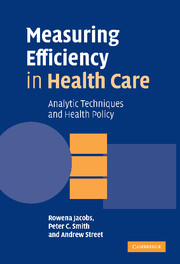Book contents
- Frontmatter
- Contents
- List of figures
- List of tables
- Preface
- Acknowledgements
- List of abbreviations
- 1 Efficiency in health care
- 2 The components of an efficiency model
- 3 Stochastic frontier analysis of cross-sectional data
- 4 Stochastic frontier analysis of panel data
- 5 Data envelopment analysis
- 6 The Malmquist index
- 7 A comparison of SFA and DEA
- 8 Unresolved issues and challenges in efficiency measurement
- 9 Some alternative approaches to measuring performance
- 10 Conclusions
- Appendix: Data description
- References
- Author index
- Subject index
7 - A comparison of SFA and DEA
Published online by Cambridge University Press: 10 December 2009
- Frontmatter
- Contents
- List of figures
- List of tables
- Preface
- Acknowledgements
- List of abbreviations
- 1 Efficiency in health care
- 2 The components of an efficiency model
- 3 Stochastic frontier analysis of cross-sectional data
- 4 Stochastic frontier analysis of panel data
- 5 Data envelopment analysis
- 6 The Malmquist index
- 7 A comparison of SFA and DEA
- 8 Unresolved issues and challenges in efficiency measurement
- 9 Some alternative approaches to measuring performance
- 10 Conclusions
- Appendix: Data description
- References
- Author index
- Subject index
Summary
Introduction
The previous four chapters have examined stochastic frontier analysis and data envelopment analysis in detail. We have described the methodologies and touched on the main strengths and limitations of each. In this chapter we compare the two techniques. First, we consider why they might produce different estimates of organisational efficiency. We then outline the other key dimensions on which the techniques differ. This is followed by an empirical comparison, using some of the cross-sectional data analysed in the previous chapters. We conclude by making recommendations as to how best to interpret organisational efficiency estimates according to their sensitivity to analytical approach and modelling assumptions.
Why SFA and DEA produce different efficiency estimates
Many studies find that the results of applying SFA and DEA lack consistency, even when exactly the same variables and data are used. There are two main reasons for discrepancies in the efficiency estimates derived from the two broad analytical approaches:
differences in how the techniques establish and shape the efficiency frontier;
differences in how the techniques determine how far individual observations lie from the frontier.
Given that the true frontier is unobservable, the question arises as to how best it should be approximated. Is the economic theory pertaining to the analysis of efficiency sufficiently well-established to outweigh the appeal of simply relying on best practice as revealed by the data to hand?
- Type
- Chapter
- Information
- Measuring Efficiency in Health CareAnalytic Techniques and Health Policy, pp. 151 - 166Publisher: Cambridge University PressPrint publication year: 2006
- 2
- Cited by



